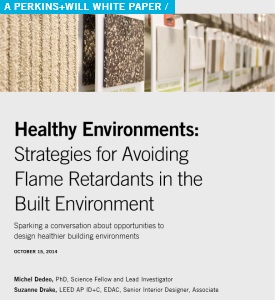
by Brianna Crandall — November 12, 2014—Global architecture and design firm Perkins+Will has released new research to bring awareness to the need for architects and interior designers to develop a better understanding of flame retardants and their impact on the health and wellbeing of building occupants. The publication can inform facilities managers as they procure furniture and oversee renovations and other projects.
Flame retardants in the built environment are associated with a range of health impacts including cancer, endocrine disruption, and neurodevelopmental problems, reminds the firm. Many flame retardants are persistent, bioaccumulative, and/or toxic, and their use in buildings is largely avoidable, adds P+W.
The white paper, titled Healthy Environments: Strategies for Avoiding Flame Retardants in the Built Environment, available for download from the P+W Web site, was developed by Perkins+Will’s Healthy Materials Group and Science Fellow Michel Dedeo. It identifies both new and existing opportunities to design healthier buildings without compromising fire safety or code compliance.
Perkins+Will’s white paper includes a list of 193 flame retardants, including 29 discovered in building and household products, 50 discovered in the indoor environment, and 33 discovered in human blood, milk, and tissues. The research can help designers identify which products should be subjected to extra scrutiny during the design and construction process, and it provides options for less hazardous alternatives. The white paper also helps to identify gaps in current understanding of the sources and paths of chemical exposure.




